|
Commonwealth War Graves Commission
(CWGC) |
|
Gran
Bretagna |
|
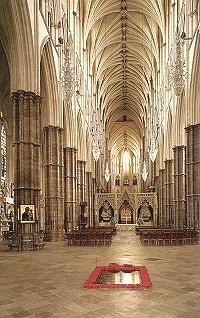 |
|
La selezione del milite ignoto, destinato alla navata dell’abbazia di Westminster
(a fianco) a Londra, cominciò nei campi di battaglia di Francia dove i resti di 4 sconosciuti furono dissepolti a Aisne, Somme, Arras e Ypres. A novembre del 1920 le salme raggiunsero la chiesa di St. Pol
(Francia) dove il Brigadiere Generale L.J. Wyatt indicò, nella cappella, il solo militare che sarebbe ritornato in patria. Tre cappellani officiarono l’8 novembre la funzione religiosa. Il feretro raggiunse scortato Boulogne sur mer per imbarcarsi verso l’Inghilterra.
(escorted under a French honor guard to Boulogne, drawn by a wagon with six horses and following by a mile-long procession). Una targa posta sul sarcofago dice
"A British Warrior who fell in the Great War 1914-1918 for King and
Country". La traversata approdò a Dover salutata da 19 colpi di cannone. Imbarcata su un treno giunse alla stazione Victoria con tutti gli onori. La bara giace sul terreno portato da Ypres perché possa condividere la terra intrisa di sangue dei compagni.
(Six barrels of Ypres earth accompanied the Unknown Soldier home to England so that his coffin might lie on the soil where so many of his comrades had lost their
lives). At the west end of the Nave in Westminster Abbey the Unknown Soldier was laid to rest after passing through an honor guard that consisted of 100 recipients of the Victoria Cross (both British and Canadian). Following the hymn "Lead Kindly Light", King George V sprinkled soil from the battlefield at
Ypres.http://www.explore-stpauls.net/index.htm |
| |
|
|
| I CIMITERI INDIANI
IN INGHILTERRA DELLA I GUERRA
MONDIALE |
|
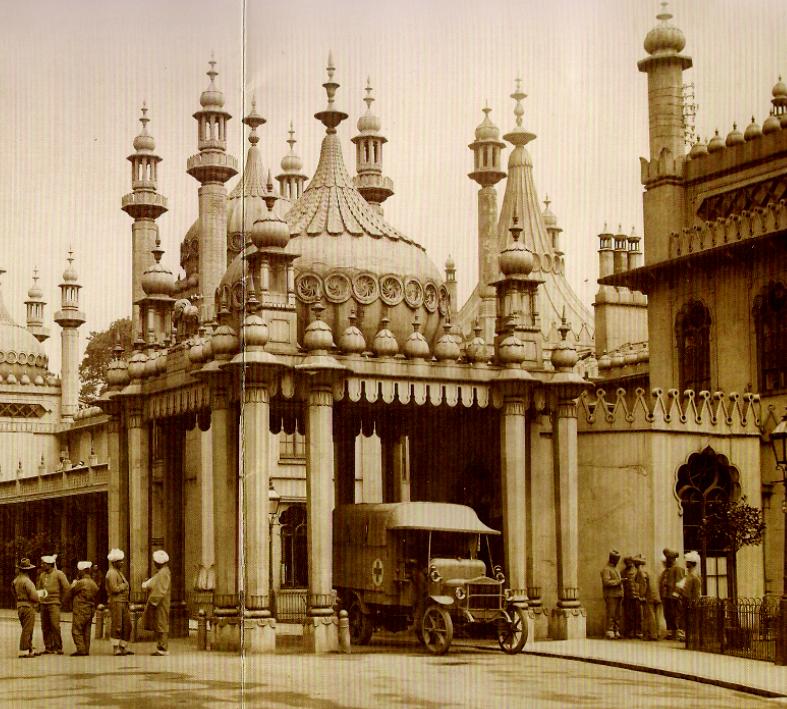
Cosi la o le
identificava (le razze) Vidya Prakash Tyagi in Martial races of
undivided India.
Martial Races Theory is an idea which is absolutely based 00 the
hypothesis that some ethnic races are naturally more martially disposed
than others. The term, Martial Race. was in the first place used by the
Britishers, who saw that the race of Scottish Highlanders were more
ferocious in battle than others races, and they applied this notion to
India. They dìfferentiated each of the ethnic group into one of two
classes; Martial Race and Non-Martial Race. Martial Races were
considered brave and well-built for fighting. Non-Martial Races were
those whom the Britìsh considered to be unfit for fìghting. This book
covers all important Martial Races such as Ahirs, Awans, Baloch, Dhangar,
Gakhars, Garhwalis, Gujjars, Gurkhas, Jat, Kamboj, Kurmis, Marathas,
Nagas, Nairs, Pashtuns, Rajputs and Sikhs.
The lndian revolt of 1857 might bave played a rolo in British support 0f
the martial races theory. Throughout this rebellion some Indian troops,
especially in Bengal, rebelled, but the "loyal Sikhs Punjabis. Dogras,
Gurkas, and Pakhtuns (Pathans) did not join thr mutiny and fought on the
side of the British Anny. Recent scholars have proposed that this theory
was used to the limit to increase enlisting from
amongst these races, while determing enlistment of "distoya" Indians who
had sided with the rebel army during the war. The Indian subcontinent
has been home to a innumerable range of racial groups throughout the
history making it one of the most genetically rich areas on the world
today. |
|
L’esercito indiano di Sua
Maestà ebbe un ruolo significativo allo scoppio della guerra. Francesi e
in misura maggiore Inglesi non avevano un esercito di massa e comunque
non avevano completato le procedure dei richiami che necessitano di
mesi. L’Inghilterra da sempre aveva un piccolo esercito professionale
(anche per motivi interni di nazionalità) non assolutamente paragonabile
alla leva di massa tedesca già in atto da 50 anni.
Per tamponare il tempo necessario ad organizzarsi gli inglesi (come i
Francesi) fecero leva sui soldati coloniali e dei dominion. L’India
inglese, che non è quella attuale, poiché all’epoca comprendeva terre
dall’Afghanistan alla Birmania passando per il Pakistan, poteva fornire
decine di migliaia di uomini (236.000 uomini erano in servizio con
compiti di difesa dei confini ma anche d’ordine interno). Gli indiani
non erano mai usciti dall’India e mal si prestavano ad altri climi, come
quello nord Europeo. Molti arrivarono con la divisa estiva e la tennero
per diversi mesi fino ad inverno inoltrato. Alla fine del 1915 (dopo un
anno di guerra) con ca. 30.000 uomini in servizio ne avevano già perso
per ferite 14.000 e per morte 3.000. Le ferite o le malattie erano
numerose sia per le condizioni della trincea (gas compresi) che per
l’uso indiscriminato di mitragliatrici da parte tedesca. Molti ospedali
dovettero quindi essere aperti sulle coste meridionali dell’Inghilterra
e quello di Brighton (Royal Pavillon) è uno. I soldati venivano da 5
gruppi etnici ben distinti anche se le religioni non sempre erano
spartite in maniera uguale. C’erano induisti, mussulmani e sikhs che pur
essendo solo il 2% della popolazione fornivano 1/4 degli effettivi. Gli
altri gruppi etnici erano i Gurkhas che appartenevano al regno
indipendente del Nepal, i Pashtuns afghani, i Dogras (tutte e tre le
religioni dal Kashmir)), gli Jats dal Punjab, ma venivano assoldati solo
gli Hindù e i Mussulmani del Punjab che fornivano il 50% della forza.
Tutte queste regioni erano nel Nord Ovest dell’India e c’era un motivo
di fondo “vecchio” da decine di anni – La razza marziale o Martial race.
Naturalmente le razze marziali, approfondite nel 1880, erano poi non
intelligenti ed erano costituite da “campagnoli” analfabeti attratti
dalla paga. I “cittadini” erano troppo intelligenti ed influenzati dalle
dottrine socialiste. La caduta della colonia indiana sarà infatti dovuta
non dalle razze marziali ma da un avvocato (veramente ben elaborata come
teoria).
A dicembre del 1914 cominciarono ad affluire i feriti (i morti venivano
seppelliti in Francia). La divisione di religione comportava anche
padiglioni separati e cibi ad Hoc, senza parlare di latrine, luoghi di
preghiera e personale medico e infermieristico che doveva essere
strettamente della stessa razza e religione. Ci si avvaleva per questo
degli studenti in medicina indiani (bilingue) e dei dottori che avevano
prestato servizio in India.
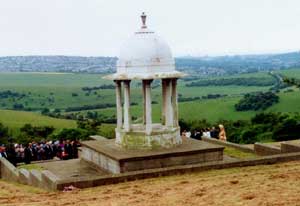
Alla prima occasione, quando il reclutamento inglese ebbe termine (1916)
molti “Indiani” vennero trasferiti in Egitto.
I decessi che si verificavano tra i malati e feriti gravi comportavano
poi una divisione delle operazioni funebri come dei luoghi di sepoltura.
Gli Hindus e i Sikhs venivano cremati e le ceneri disperse in mare. Per
loro quindi resta solo il Chattri memorial dedicato in seguito anche a
tutti gli altri che avevano combattuto. Per le sepolture mussulmane si
ricorreva alla Moschea Shah Jehan a Woking e sepolti li vicino a Horsell.
Nel 1969 le inumazioni del cimitero di Woking vennero traslate in un
altro Mussulmano, già in uso durante la guerra il Brookwood.
Over 800,000 Indian troops fought in many
conflicts of the Great War in support of Britain. The Indian Corps lost
over 74,000 men with 69,000 wounded and earned 130,000 medals including
12 Victoria Crosses. Around 16% of soldiers serving in Europe were of
the British Indian Army. |
|
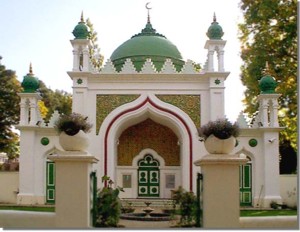
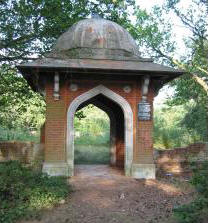 |
|
The Chattri
(sopra a dx) The memorial
now known as the Chattri was erected after the war, and unveiled by the
Prince of Wales on the 21st February 1921. The memorial was built on the
exact spot where the bodies of Indian soldiers had been cremated. The
Chattri bears the following inscription, in Urdu, Hindi and English: “To
the memory of all Indian soldiers who gave their lives for their
King-Emperor in the Great War, this monument, erected on the site of the
funeral pyre where the Hindus and Sikhs who died in hospital at Brighton
passed through the fire, is in grateful admiration and brotherly
affection dedicated”. Today the Chattri can be seen from many parts of
the town - a white memorial within an area of green, marked off by a
square of trees.
The Shah Jahan Mosque, Woking (qui a sx)
When a Muslim died while in one of the many
Indian hospitals in Brighton and Hove, his body, in charge of one of his
own people, was taken in a motor hearse and with a Muslim doctor, was
sent to Woking, where it was received by a Muslim priest and buried with
the rites of his religion in a special section of the cemetery, The
funeral would be a military one, the firing party being supplied by the
nearest troops. The site in Woking was built during World War I 1914 -
1918 to receive burials of Muslim Indian Army soldiers who died while in
one of the many specially converted Indian Military hospitals in
Brighton and Hove. 19 Moslem bodies were taken from Brighton to The Shah
Jehan Mosque in Woking. During the 1960s the bodies were removed to a
Military Cemetery at Brookwood Cemetery due to vandalism. The Shah Jehan
Mosque opened in 1889. |
|
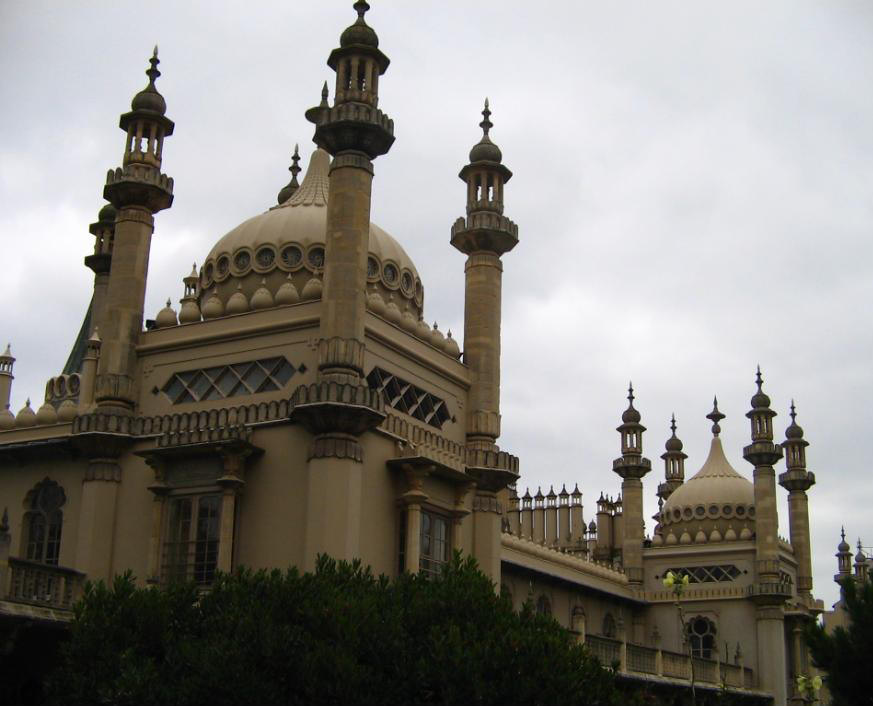 |
|
The Royal Pavilion,
Brighton, summer house was built by George IV (1762 -1830) when he was
Prince Regent from 1811. Governing as Regent for his father, George III
(1738- 1820 who was thought to be mad), George IV had a reputation for
gambling, womanizing. In the early 19th century, his architect, John
Nash, slapped a cast iron framework around an older, simpler farmhouse
and, well, just went to town, really. The pseudo Indian palace, with
Chinese influenced interiors is a riot of color, expensive fabrics,
crystal and gilt.
Il Royal Pavilion di Brighton opera di John Nash era
la splendida residenza estiva costruita da Giorgio IV quando era
principe reggente per suo padre, Giorgio III, che veniva dato per matto.
Giorgio IV era un giocatore accanito, donnaiolo e uno che viveva come si
dice sopra le righe in un'era che le grandi esplorazioni e i paesi
esotici avevano portato alla attenzione delle cronache (come la
spedizione/campagna di Napoleone in Egitto). Il palazzo pseudo indiano,
con influenze cinese negli interni è un tripudio di colori, tessuti
costosi, cristallo e oro.
Iniziata la costruzione per trasformazione di una villa
di campagna assurse a queste dimensioni negli anni fra il 1802 e 1822.
La cittadina crebbe
intorno al palazzo con alberghi e affollamento (spiaggia alla moda) e la
Regina Vittoria vendette il palazzo nel 1850. Il primo passo verso la
trasformazione in colonia dell'India fu l'approvazione, nel 1784, dell'Indian
Act, che concedeva ai governatori generali della Compagnia delle Indie
la facoltà di agire (e di espandersi) in nome del governo di Londra
oltre ad avere il monopolio degli scali e dei commerci. Nel 1818, gli
inglesi dominavano, ormai, tutta l'India, a eccezione del bacino
dell'Indo e dell'Assam. Amministravano in maniera diretta la regioni più
ricche, il Bengala e Delhi, con l'unica eccezione del regno Sikh, nel
Nord-ovest. Occorrerà ancora qualche decina d'anni però per avere la
colonia Indiana come vista sopra.
http://www.guardian.co.uk/culture/2010/apr/18/brighton-pavilion-war-indian-hospital
|
| |
|
COMMONWEALTH |
|

Sacrario Polacco di S. Lazzaro di Savena
I polacchi erano equipaggiati, addestrati e inseriti in unità Inglesi |
|
Nearly 50,000 Commonwealth dead of the two world wars are buried or commemorated in Italy. Most of the Commonwealth
dead of the First World War, numbering approximately 4,000, are buried in several war cemeteries or plots in the north of
Italy. The Commission's principal architect for these cemeteries was Sir Robert Lorimer and it was his simple treatment,
blending them with their beautiful surroundings, that prompted the Commission's founder, Sir Fabian Ware, to comment that
the cemeteries in Italy were some of the "most impressive I have seen". Of the Second World War casualties, some 38,000 are buried in thirty-seven Commonwealth war cemeteries; 1,500 whose remains were cremated are commemorated on memorials in three of the
cemeteries; over 4,000 soldiers whose graves are unknown are commemorated on the Cassino Memorial; those of the missing sailors and airmen are commemorated on memorials at their home ports and on the Air Forces Memorial at Malta. The Commission's principal architect for the Second World War cemeteries was Louis de Soissons and the first cemetery to be completed was at Catania in 1949. The cemeteries and memorials in Italy are maintained by the Commission's own staff under the direction of the Western Mediterranean Area Office in Rome.
Consideriamo Commonwealth in questo capitolo anche Ebrei,
Polacchi Greci e Gurka Nepalesi inseriti ed equipaggiati in grandi unità
inglesi. |
Libya War Cemetery |
|
CIMITERI AFRICANI
DELLA II GUERRA MONDIALE |
|
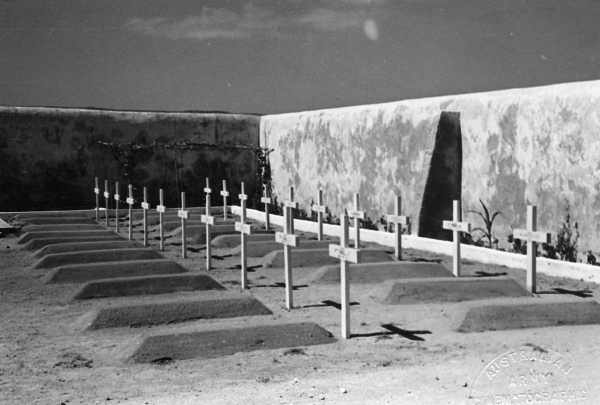
|
|
In africa settentrionale ci sono 5 cimiteri
quello del vicino medioriente in Libano. Le sepolture sono a Knightsbridge,
Tripoli, Bengasi e Tobruk. Passata di mano varie volte,
Tobruk venne occupata stabilmente solo dopo El Alamein. 5 miglia fuori dalla città, sulla strada
per Alessandria d’Egitto sorge il cimitero dove riposano 1.200 inglesi, 3 canadesi, 560 australiani, 40 neozelandesi, 160 sudafricani, 130 polacchi, 15
cecoslovacchi, alcuni francesi e greci e 20 centrafricani di colore. Hanging from the wall of the gate house is the bell from HMS
Liverpool, to symbolize the critical part played by the Navy in bringing in essential supplies and ammunition during the
seige. Without that help, Tobruk would have fallen. Inside the entrance, on the central
path, is a stone obelisk commemorating the Australian dead, replacing the original concrete memorial erected by Australian
soldiers. |
| |
|
|
|
 |
|
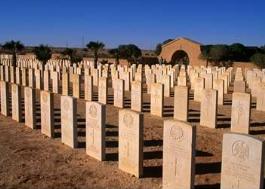 |

|
 |
|
Tripoli War Cemetery is at
Babgagaresh, 3
km west of the city of Tripoli, in the Strada della Mura, a minor road off the main road to Sabratha and the Tunisian
border. |
|
| |
|
|
|
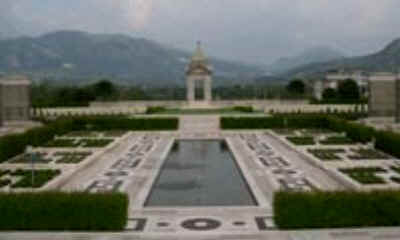
ANZIO e CASSINO verranno descritti a parte assieme
agli statunitensi |
|
Gli Inglesi a differenza degli americani non concentrarono i loro caduti in pochi grandi sacrari, ma li
tumularono sui campi di battaglia in cui erano caduti in decine di piccole e difficili strutture alla cura dell’apposita commissione e al rispetto della popolazione Italiana. Tale sistema rende ogni autorità locale più consapevole e meno soggetta a dimenticare il contributo che questi soldati di diverse nazionalità diedero alla liberazione d’Italia. I Cimiteri italiani di caduti stranieri (Commonwealth ma anche Ebrei,
Polacchi Greci e Gurka Nepalesi che qui consideriamo come una sol cosa) sono indicati in ordine alfabetico. Cimiteri in cui sono sepolti soldati del
Commonwealth (o equiparati) qui non elencati
Polacchi che hanno Montecassino nella apposita pagina e gli altri nella
pagina Europa del monumento nazionale di Varsavia, e singole sepolture non
classificate in Cimiteri civili come S. Michele (Cagliari),
Messina, Staglieno (Genova), Torino etc.... La dislocazione di alcuni cimiteri
non corrisponde al campo di battaglia ma all'ospedale militare in cui
venivano ricoverati in gravissime condizioni. In alcuni casi si può
parlare di sepoltura nell'ambito del campo di prigionia in cui erano
detenuti o area in cui era caduto un aereo in combattimento.
http://battlefieldsww2.50megs.com/
|
| |
|
|
|
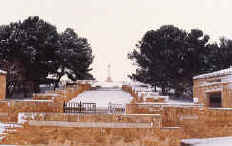 |
|
AGIRA CANADIAN WAR CEMETERY
Enna (490 burials) After the fall of Sicily, the graves of all Canadians who died during the campaign were concentrated into this cemetery. This site was selected by Canadian officers in September 1943. The cemetery lies in the
Comune of Agira, Province of Enna.
A valle di Agira, parte est, poco dopo oltre
il bivio per Gagliano Castelferrato, una collinetta, accoglie uno dei
tre cimiteri di guerra Canadesi realizzati in Sicilia (Agira, Catania,
Siracusa),dalle forze anglo-americane. Questo posto in provincia di Enna
fu scelto dal Comando canadese nel settembre 1943. |
| |
|
|
|
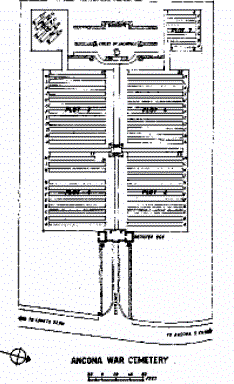 |
|
ANCONA WAR CEMETERY (1,019 burials) The cemetery site was chosen in September 1944, when burials were brought in from a wide surrounding area. They include casualties from the first attacks on the eastern sector of the Gothic Line at the end of August and early in September 1944. Ancona was captured by Polish forces on 18 July 1944, and served as the main supply port for the attack on the Gothic Line and for the final breakthrough the following spring at Argenta. The cemetery lies in the rural locality of Tavernelle, in the Comune and Province of Ancona, 3 kilometers south of the town of Ancona.
Il Cimitero di Guerra di Ancona accoglie 1.019
Caduti. La decisione di creare un cimitero di guerra, accanto a quello
comunale delle Tavernelle, fu presa nel settembre 1944. Accoglie i Caduti
del versante adriatico del fronte fino alla linea Gotica tra la fine di
agosto e l’inizio di ottobre 1944. |
| |
|
|
|
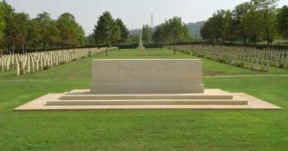 |
|
AREZZO WAR CEMETERY (1,266 burials) This site was selected in November 1944, when burials were brought in from the surrounding area. The Germans made a stand in front of Arezzo in July 1944 and there was fierce fighting before the town was taken on 16 July by the 6th Armoured Division with the aid of the 2nd New Zealand Division. Both the 4th and the 8th Indian Divisions were involved in the fighting in this region, and Plots VII-IX in the cemetery are Indian plots.
Il Cimitero di Guerra di Arezzo accoglie 1.266
Caduti. Scelto nel novembre 1944 per dare sepoltura ai caduti della tenace
resistenza tedesca contro la 6a Divisione Corazzata con l’aiuto della 2a
Divisione neozelandese. Sia la 4° che l’8a Divisione Indiana furono
coinvolte in questi combattimenti ed i riquadri VII, VIII, IX del cimitero
sono indiani. |
|
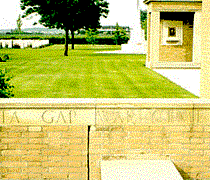 |
|
ARGENTA WAR GAP CEMETERY The Cemetery lies in the Comune of Argenta. The
town of Argenta is 2 kilometres south of the cemetery on the SS16
connecting Ravenna with Ferrara. The site of the cemetery was chosen by
the 78th Division for battlefield burials, and the cemetery was later
enlarged by the bringing in of burials from the surrounding district. It
marks the final stages of the hard fighting in Italy in the spring of
1945, and contains among others the graves of many men of the Commandos
engaged in the amphibious operations on the shores of the Comacchio
lagoon early in April 1945. There are now over 600, (1939-45) casualties
commemorated in this site. Of these, a small number are unidentified.
Il Cimitero di Guerra di Argenta (Argenta Gap)
accoglie 625 Caduti. Il posto del cimitero fu scelto dalla 78a Divisione e
successivamente ampliato. Accoglie i Caduti della fase finale della
campagna, nella primavera del 1945, compresi quelli delle truppe d’assalto
impegnati nelle valli di Comacchio.
|
| |
|
|
|
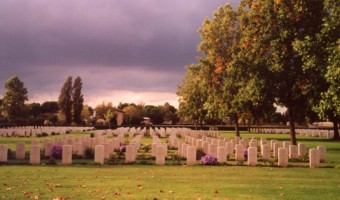 |
|
ASSISI WAR CEMETERY ( 945 burials) The site was selected in September 1944, when burials were brought in to this cemetery from the surrounding battlefields. A high proportion of them date from June and July 1944, when the Germans were making their first attempts to stop the Allied advance north of Rome. The cemetery forms part of the locality of Rivotorto in the
Comune of Assisi, in the Province of Perugia
|
| |
|
|
|
Cimitero di Guerra Britannico di Bari.
Accoglie 2.164 Caduti. Situato a sud-est di Bari sulla rotabile per
Carbonara, ad occidente della SS n. 100 per Taranto. Le tombe
appartengono a 1.548 Caduti del Regno Unito, 210 canadesi, 41
Australiani, 162 Sud Africani, 72 Neozelandesi, 47 Indiani e le
rimanenti di altri 5 Stati diversi. Anche in questo Cimitero spicca il
simbolico blocco marmoreo della “Pietra del Ricordo” ed è presente la
“Croce del Sacrificio |
|
BARI WAR CEMETERY (2,213
burials) This site was chosen in November 1943. There was no severe fighting in the vicinity of the town, which was the Army Group headquarters during the early stages of the Italian campaign, but it was an important supply base and a hospital centre. Besides garrison and hospital burials, the cemetery contains graves brought in from a wide area of south-eastern Italy and men who died in two disastrous explosions at Bari. Some 90 casualties of the 1914-1918 war were brought into this cemetery in 1981 from Brindisi Communal Cemetery.
210 are cenadians. The cemetery lies south of Bari in the locality of Carbonara.
|
| |
|
|
|
 |
|
BOLSENA
WAR CEMETERY is situated on the eastern side of Lake Bolsena just west of the SS2, between Rome (104 kilometres) and Siena (115). The Germans made their first stand after being driven north of Rome at Bolsena and to the east of Lake Bolsena, there was a tank battle in June 1944 between the 6th South African Armoured Division and the Hermann Goering Panzer Division. The site for the cemetery was chosen in November 1944, and graves were brought in from the battlefields between Bolsena and Orvieto. Almost one-third of those buried at Bolsena were South Africans. Later, graves were brought into the cemetery from the Island of Elba. The cemetery is on the actual site of the first camp occupied by General Alexander's advanced headquarters after the liberation of Rome and it was here that King George VI visited General Alexander at the end of July 1944. Bolsena War Cemetery contains 597 Commonwealth burials of the Second World War, 40 of them
unidentified.
Il
Cimitero di Guerra di Bolsena accoglie 597 Caduti. Questo cimitero fu
scelto nel novembre 1944, e accoglie i Caduti dell’area di Orvieto e
Bolsena oltre a quelli dell’Isola d’Elba. Quasi un terzo dei Caduti sono
sudafricani appartenenti alla 6° Divisione Corazzata sudafricana. Il
cimitero sorge nell’area in cui era stato insediato il Quartier Generale
avanzato del Generale Alexander, dopo la liberazione di Roma. |
| |
|
|
|
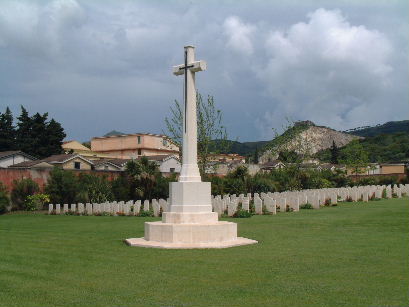 |
|
CASERTA WAR CEMETERY The
Royal Palace at Caserta served as headquarters for the Allied armies in
Italy for the greater part of the duration of the Italian campaign and
the 2nd General Hospital was at Caserta from December 1943 until
September 1945. Some of those buried here died in the hospital, others
as prisoners of war before the Allied invasion. There are also a few
burials from the October 1943 fighting on the River Volturno, which lies
not far away to the north. Caserta War Cemetery contains 768
Commonwealth burials of the Second World War. After 2.0 kilometres (eastern
edge of the Royal Gardens), turn right and proceed directly westward for
0.8 kilometres, then turn southward down an incline. After a distance of
0.3 kilometres there will be a large Communal Cemetery located on the
left; proceed to the main gates and the CWGC plot will be found at the
end of this road.
|
| |
|
|
|
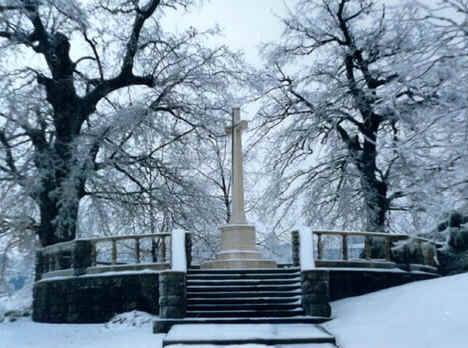 |
|
Castiglione dei Pepoli South African
War Cemetery is at a height of over 2,000 feet, about 30 miles north of Florence on the road to Bologna through Prato; the cemetery lies just to the north of the town. It was started in November 1944 by the 6th South African Armoured Division which had entered Castiglione at the end of September and remained holding positions in the area throughout the winter until the following April. Many of the burials were made direct from the Apennine Mountains battlefields. Four fifths of those buried here were South Africans, while the remainder were mostly from the British 24th Guards Brigade, then under the command of the South African Division. There is a memorial building in the cemetery which the South Africans erected. The cemetery contains 400 South African and 100 British burials. It is the only war cemetery in the Commission's care with 'South African' in its
title.
|
| |
|
|
|
TO SAVE MANKIND YOURSELVES YOU SCORNED TO SAVE,
http://www.cwgc.it/areewma/Italia/Listacimiteri/Cimiterihtm/Castiglione.htm The memorial building contains two tablets which were unveiled by Field Marshal Jan Christaan Smuts, the South African statesman, which read:
M DIE MENSDOM TE DIEN HET JUL VEILIGHEID VERSMAAD |
|
Il 3 settembre 1943 gli Alleati
iniziarono la risalita dallo stretto di Messina. Pochi giorni la
diffusione del testo dell'Armistizio che cessava per noi le ostilità.
Roma venne raggiunta solo nel giugno 1944. I tedeschi anche prima si
ritiravano su linee fortificate (fatte con operai e soldati prigionieri)
in successione. L'ultima di queste, la Linea Gotica, sulle montagne degli Appennini settentrionali, fu sfondata dagli Alleati
solo nella primavera del 45. Durante la campagna d'autunno il fronte avanzò lentamente
solo sulla costa adriatica fino a Ravenna. Il Cimitero Sudafricano di Castiglione
dei Pepoli fu iniziato nel novembre 1944 dalla 6a Divisione Corazzata Sudafricana, entrata
in paese e, rimasta nelle vicinanze fino all'aprile successivo. Molte della sepolture furono fatte direttamente dai campi di battaglia degli Appennini, dove durante quell'inverno le truppe sudafricane tennero le posizioni 8 km circa a nord di Castiglione. La maggior parte degli uomini sepolti in questo cimitero era sudafricana, il resto apparteneva per lo più alla 24a Brigata delle Guardie,
unità della 6a Corazzata Sudafricana.
Il cimitero contiene 502 sepolture.
|
| |
|
|
|
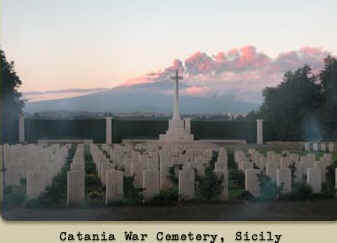
|
|
Cesena War Cemetery lies in the Comune of Cesena, in the Province of Forli, and is situated 2 kilometre north-east of Cesena railway station on the provincial road to Cervia (Route No.71 bis). It is on the right, hidden among trees and vineyards. You can get to it through a farmhouse's private entrance. The cemetery site was selected by the Army in November 1944, and the cemetery was formed by concentrations from the surrounding battlefields. Those buried here died for the most part during the advance from Rimini to Forli and beyond in September-November 1944, an advance across one flooded river after another in atrocious autumn weather. There are now over 750, 1939-45 war casualties commemorated in this site (Canada). Of these, a small number are unidentified.
Il cimitero si trova a 2,5 km a nord-est del Centro di Cesena sulla via secondaria che conduce a Cervia. Dopo aver attraversato la ferrovia, il cimitero si trova circa 2 km piu' avanti sulla destra. E' nascosto alla vista da alberi e vigneti. Attualmente lo si può raggiungere attraverso l'ingresso privato di una fattoria.
Il Cimitero di Guerra di Cesena accoglie 775 Caduti. Il cimitero fu
allestito per i Caduti nelle battaglie avvenute nelle zone circostanti nel
novembre 1944, ovvero durante l’avanzata su Rimini e Forlì ed oltre. |
|
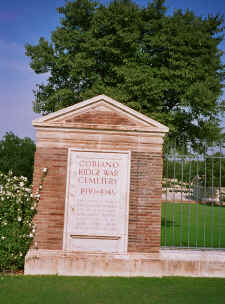
|
|
|
| |
CERETOLA DI CONIALE
war cemetery Piccolo cimitero dei Caduti inglesi. (Firenzuola), English war Cemetery. there are the corpses of the soldiers of the Commonwealth fallen along the Valley of the Santerno (269 known English, 6 unknown; 10 known Canadians; 2 known sudafricanis; in total 281 fallen known, 6 unknown).
Il Cimitero di Guerra della valle del Santerno
accoglie 287 Caduti. Il Cimitero fu costruito dalla 78a Divisione
Britannica durante le operazioni in questa area svolte dalla fine del 1944
al maggio1945. |
| |
|
|
|
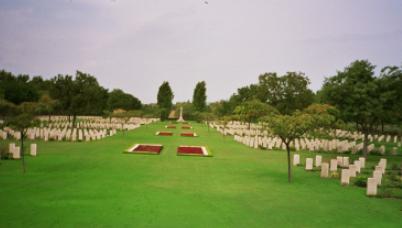 |
|
Coriano war cemetery
Via Piane, 4 The cemetery is located on a hillside 1 and a half km south of the main road
(SS.16) ranging from Pesaro to Rimini. The road for the cemetery is 4 Km east of Cattolica. It hosts
n.1939 tombs (di cui 1411 inglesi, 427 canadesi, 52 neozelandesi, 28 sudafricani, 8 indiani, 1 russo, 1 australiano e altri ignoti). Il
Cimitero di Guerra di Coriano (Coriano Ridge) accoglie 1.939 Caduti.
Coriano fu l’ultimo serio ostacolo all’avanzata alleata nel settore
adriatico verso la linea Gotica nell’autunno 1944. I tedeschi opposero una
seria resistenza reattiva tra il 4 e il 12 settembre 1944. Questi
combattimenti, protrattisi nelle giornate successive, furono i più duri
dopo lo sfondamento di Cassino. In media i Caduti giornalieri erano circa
150. Il cimitero fu organizzato nel 1945. |
| |
|
|
|
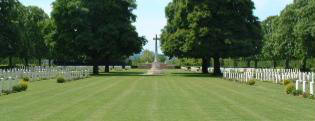 |
|
FAENZA WAR CEMETERY
The war cemetery was formed in the winter
of 1944 for the burial of those who were killed in the static fighting
before the Allied advance was renewed in April 1945. Faenza War Cemetery
contains 1,152 Commonwealth burials of the Second World War.
Il Cimitero di Guerra di Faenza accoglie 1.152
Caduti. Il cimitero venne costruito nel novembre 1944 ed accoglie i Caduti
dell’avanzata tra Rimini e la linea Gotica. |
| |
|
|
|
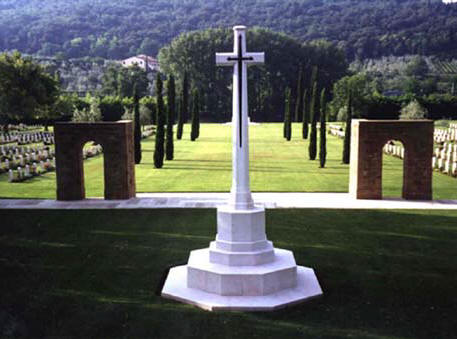 |
|
FLORENCE WAR CEMETERY
Firenze. Following the fall of Rome to the Allies in June 1944, the German retreat became ordered and successive stands were made on a series of defensive positions known as the Trasimene, Arezzo, Arno and Gothic Lines. Florence, which was taken by the Allied forces on 13 August 1944, was the centre of the Arno line and the point from which the attack on the German Gothic Line defences in the Apennines was launched. The site for the war cemetery was selected in November 1944 for burials from the hospitals established in and around Florence but the greater part of those buried here lost their lives in the fighting in this area from July to September 1944. After the war, 83 graves were moved into the cemetery from nearby Arrow Route Cemetery, when it proved impossible to acquire the site in perpetuity. Most of these burials were from the fighting in the Apennines during the winter of 1944-1945. Florence War Cemetery now contains 1,632 Commonwealth burials of the Second World War.
Il Cimitero di Guerra di Firenze accoglie 1.632
Caduti. Il luogo ove sorge il cimitero fu scelto nel novembre 1944 ed
accoglie per lo più i deceduti negli ospedali di Firenze e dintorni. |
| |
|
|
|
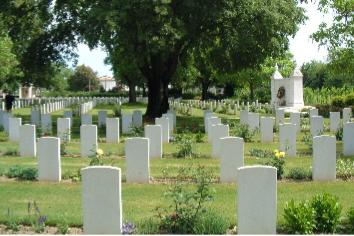 |
|
Foiano della Chiana Commonwealth War Cemetery
Loc. Renzino Arezzo Le operazioni militari che si svolsero nell’area
del Trasimeno nella terza decade del giugno 1944 videro impegnate due divisioni alleate, impiegate nella avanzata, più una nel settore di Chiusi.
Un totale di circa 20.000-30.000 uomini, metà dei quali impegnati nei
combattimenti. Le perdite alleate, secondo Janet Kinrade Dethick , (The Trasimene Line) furono di 330 caduti e circa 700 feriti. A Foiano della Chiana nel Commonwealth War Cemetery riposano le spoglie di 256 soldati |
| |
|
|
|
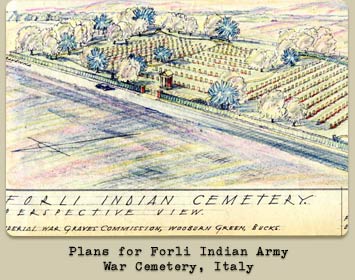 |
|
FORLI INDIAN ARMY WAR CEMETERY The war cemetery lies in the Comune and Province of Forli in north-east Italy on the right bank of the river Montone. The site of the cemetery, a mile and a half north of the town, was chosen in December 1944 by the 10th Indian Division, which had come into the Adriatic sector south of Cesena early in the previous October. The division buried not only their own dead but also some from 4th Indian Division which had preceded them in the area, and from the 8th Indian Division, which fought on this front in the spring of 1945. The 10th Division had played an important part in the heavy fighting in appalling weather between their arrival and the end of the year, suffering considerable casualties. The cemetery contains 500 burials from India and another 770 names of Hindus and Sikhs on the Cremation Memorial. This is one of three cremation memorials in Italy, the others being at Rimini, and the Sangro River |
|
Nel Cimitero di Guerra di Forlì (Monumento
Commemorativo delle Cremazioni Indiano) sono
accolti 495 Caduti. Il luogo in cui si trova il cimitero fu scelto dalla
10a Divisione Indiana arrivata al fronte nell’ottobre 1944 ed impegnata in
duri combattimenti fino al dicembre 1944. All’interno di questo Cimitero
di Guerra si trova il Monumento Commemorativo delle Cremazioni (769
Caduti) dedicato agli Ufficiali e soldati Hindu e Sikh che a differenza
dei Mussulmani indiani si fanno cremare. |
|

Il Cimitero di Guerra di Gradara accoglie 1.191
Caduti. Qui ci sono i Caduti dell’avanzata da Ancona a Rimini e
quelli per la conquista di Rimini, avvenuta il 21 settembre 1944. Sorge
sulla collina di fronte al castello di Gradara. |
|
Gradara War Cemetery is situated in the Comune of Gradara (CASTLE) in the Province of Pesaro. It is located about 1.5 kilometres south of the SS16, midway between Pesaro and Riccione. This cemetery is steeply terraced with numerous steps, although there is limited access for visitors with wheelchairs. The site for the cemetery was chosen in November 1944 and it contains the graves of casualties incurred during the advance from Ancona to Rimini (which broke the Gothic Line) and in the heavy fighting around Rimini, which was taken by the Allies on 21st September 1944. There are now 1191, 1939-45 war casualties commemorated in this site. Of these, 5 are unidentified. There is also 1 Belgian Foreign National casualty buried in the site.
( 805 inglesi, 369 canadesi, 2 australiani, 13 sudafricani, 2 indiani) |
| |
|
|
|
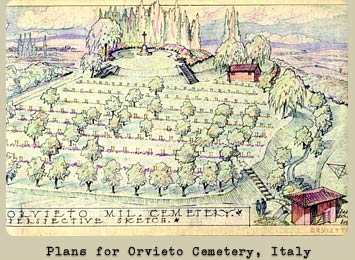
|
|
Meldola War Cemetery lies in the Comune of Meldola, in the Province of Forli. It is located south of the SS9 from Bologna to Rimini, 10 km south of Ronco, itself equidistant between Forli and Forimpopoli. Meldola War Cemetery was originally a battlefield cemetery of the 46th Division, into which a few burials were concentrated; they all date from the last week of October and the month of November 1944. Meldola itself was taken on 30th October, and in the ensuing month the 46th and 4th Divisions advanced to the Lamone River. There are now over 100, 1939-45 war casualties commemorated in this site.
It is located in Via Gualchiera, right outside the historic centre.The Commonwealth cemetery was built between 1940 and 1950.Its architectonic structure is similar to the one of the other Commonwealth cemeteries that had been built in Italy. The cross dedicated to the sacrifice of the solders buried here rises on an octagonal pedestal. The 145 gravestones are exactly the same; there is no distinction of military grade, social class, race or religion. The name of the solder, his grade and the battalion, which he belonged to, the date of death and his age are carved on the gravestones. There is also a small building where two metal tombstones are collected; they summarize the history of the Second World War both in English and in Italian. |
| |
|
|
|
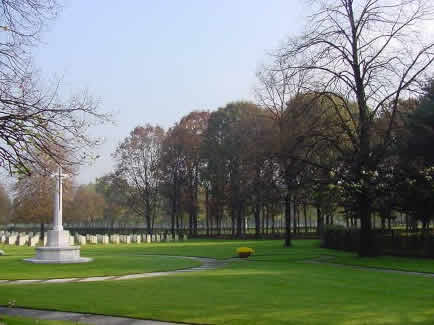 |
|
MILAN WAR CEMETERY
Cimitero Britannico di Milano Situato al parco di Trenno, nelle vicinanze della Cascina Bellaria, Raccoglie le salme di 421 militari alleati caduti durante la Seconda Guerra Mondiale, di cui 311 inglesi, neozelandesi, sudafricani, ecc.
IL PARCO DI TRENNO, costituito nel 1971, era chiamato in origine Parco Sheibler
(cascina), dal nome dell'antico proprietario: Si estende su di una superficie di 585.000
mq. un tempo agricolo di cui restano la roggia Cagnola, ormai in secca, la roggia Santa
Maria, la Cascina Bellaria.
|
| |
|
|
|
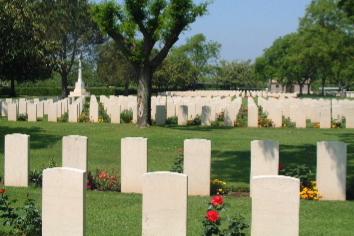 |
|
MINTURNO WAR CEMETERY Minturno is about 78 kilometres north of Naples, close to the coast. The cemetery lies several kilometres south of the town on the SS7 road to Naples and is situated in the locality of Marina di Minturno (Garigliano). Progress through southern Italy was rapid despite stiff resistance, but by the end of October, the Allies were facing the German winter defensive position known as the Gustav Line, which stretched from the river Garigliano in the west to the Sangro in the east. Initial attempts to breach the western end of the line were unsuccessful and it was not until 17 January 1944 that the Garigliano was crossed, and Minturno taken two days later. The site for the cemetery was chosen in January 1944, but the Allies then lost some ground and the site came under German small-arms fire. The cemetery could not be used again until May 1944 when the Allies launched their final advance on Rome and the US 85th and 88th Divisions were in this sector. The burials are mainly those of the heavy casualties incurred in crossing the Garigliano in January. Minturno War Cemetery contains 2,049 Commonwealth burials of the Second World War. |
|
Il Cimitero di Guerra di Minturno accoglie 2.049
Caduti per l’attraversamento del Garigliano nel gennaio1944 e quelli
Caduti sulla linea Gustav nell’inverno 1943-1944. |
|
 |
|
MONTECCHIO WAR CEMETERY Montecchio is in the comune of Sant'Angelo (in Lizzola) and in the province of Pesaro-Urbino. It is located 12 kilometres west of Pesaro and was chosen as a permanent battlefield in the autumn of 1944, when the Allies were fighting to break through the Gothic Line. During the war, Montecchio was situated on the east end and just to the south of this highly effective defensive barrier. In fact, an anti-tank ditch which formed part of the line ran through the valley that lies below the cemetery. There are 582 graves here, of which nearly half - 289 - are Canadian, including one unknown soldier. 284 tombe di
Inglesi, 6 di sudafricani, 2 di Indiani.
The majority are from the armoured units, and the Royal Regiment of Canadian Artillery is also heavily represented. In addition there is one member of the Royal Canadian Dental Corps. The remaining Commonwealth graves belong to the U.K., South Africa and India. Most of these soldiers gave their lives in this area in late August and September of 1944.
Il Cimitero di Guerra di Montecchio accoglie 582
Caduti. La cittadina di Montecchio fu distrutta dal passaggio del fronte e
l’area circostante gravemente danneggiata. I Caduti sono per lo più
canadesi. |
| |
|
|
|
 |
|
Moro River Canadian War Cemetery,
Ortona Chieti The River Moro enters the Adriatic not far from Ortona in the Province of Chieti. On 6th December 1943 Canadian forces crossed the river near its mouth and at Rogatti, about four miles up-river, after overcoming stiff German resistance. They went on to take Ortona on the 28th, after a week of bitter street fighting. In that month alone the 1st Canadian Division suffered over 500 fatal casualties. The site of the war cemetery, on high ground, was selected by the Canadian Corps in January 1944 and bodies were brought into it from the surrounding battlefields. The Canadians remained in this sector for a further three difficult months, undertaking offensive actions in January and patrolling throughout the period. The cemetery contains 1,400 Canadian burials, 170 British, 40 New Zealand, 15 South African and small numbers from Australia and India. This cemetery contains the largest number of Canadian burials in Italy.
Il Cimitero di Guerra del Fiume Moro (Ortona),
Canadese accoglie 1.613 Caduti. Il luogo fu scelto dai canadesi nel
gennaio 1944. I canadesi attraversarono il fiume Moro il 6 dicembre 1943
dopo un accanita resistenza tedesca e riuscirono a conquistare Ortona il
28 dicembre. Nel dicembre 1943 la sola 1a Divisione Canadese contò più di
500 Caduti. |
| |
|
|
|
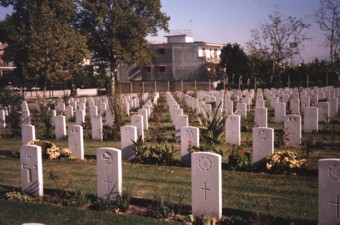 |
|
NAPOLI WAR CEMETERY
Il cimitero di Guerra di Napoli accoglie
1.202 Caduti. Il luogo fu scelto nell’aprile 1944 ed accoglie coloro che
persero la vita nei presidii ed in uno dei tre ospedali britannici
allestiti in città. Sono seppelliti qui i Caduti britannici sepolti
inizialmente nei cimiteri campani. |
| |
|
|
|
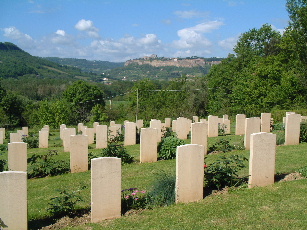 |
|
ORVIETO WAR CEMETERY Progress through southern Italy was rapid despite stiff resistance, but the advance was checked for some months at the German winter defensive position known as the Gustav Line. The line eventually fell in May 1944 and as the Germans fell back, Rome was taken by the Allies on 3 June. This cemetery was established as a battlefield cemetery by the 78th Division in the middle of June 1944, during the first heavy fighting north of Rome. The burials, with only one exception, date from the period 14 June-4 July 1944. Orvieto War Cemetery contains 190 Commonwealth burials of the Second World War.
Il Cimitero di Guerra di Orvieto accoglie 190
Caduti. Originariamente era un cimitero da campo della 78a Divisione usato
a metà di giugno del 1944 durante i combattimenti svoltisi a nord di Roma.
|
| |
|
|
|
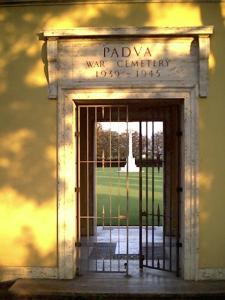 |
|
Padova Cimitero Militare
di Guerra
In questo Cimitero di via della Biscia sono sepolti 517 caduti, di cui 32 sono ignoti. Essi appartengono ai seguenti paesi: Gran Bretagna 391 Canada 15 Australia 7 Nuova Zelanda 26 Sud Africa 72 Pioneer's Corps dell'Africa del Sud 2. Altri alleati 4
|
| |
|
|
|
 |
|
 CIMITERO MILITARE EBRAICO PIANGIPANE CIMITERO MILITARE EBRAICO PIANGIPANE
La località di Piangipane, piccolo centro
di 3.000 anime è posta a 11 km a Nord - Ovest dalla città di Ravenna. Il suo territorio
sta tra le frazioni di San Michele, Santerno e Mezzano. E' sede di un cimitero di guerra dove riposano
i caduti della "Brigata Ebraica"
Si pensa che un soldato uccida o venga
ucciso: ciò che noi facemmo come soldati, fu di trovare delle persone
morte e di aiutarle a tornare alla vita. Hanoch Bartow
|
| |
|
La Brigata Ebraica |
|
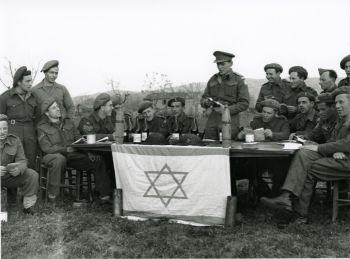 |
|
La guerra è appena scoppiata e non si conoscono ancora
gli orrori dell’olocausto. Provvedimenti restrittivi della razza presi in
Italia e Germania sono da tempo operanti, ma non si può valutarne ancora
le conseguenze, quando a Londra si apre l’ufficio reclutamento Ebreo a
cura di organizzazioni sioniste. I primi volontari a rispondere sono gli
Ebrei Inglesi che, tra uomini e donne, conteranno su una forza di circa
62.000 persone. Il governo dell’epoca, a differenza di quello che segue
(Churchill), non autorizza però i reparti omogenei, per evitare futuri
rivendicazioni politiche. A dicembre del 1940 tutti gli uomini arruolati,
disseminati in più reparti, si ritrovano all’”East Kent” Buffs. I capitani
sono inglesi; tenenti, sottotenenti e graduati sono ebrei. Segno
distintivo sull'uniforme è il "Magen David": la stella a sei punte.
Nonostante la buona volontà il reparto non viene impiegato, ed è facile
comprenderne la ragione, sempre per quanto detto sopra. Ad ogni morto
sarebbe corrisposto un debito politico: la guerra in questo modo rischiava
di essere la guerra degli Ebrei contro il nazismo e per una propria
rivendicazione territoriale (In quei tempi gli ebrei combattevano in Palestina una dura guerra contro gli inglesi, anche con attentati.
La
dottrina Ben Gurion, dopo il
Libro Bianco
*, era combattere gli inglesi, in Palestina,
come se non ci fossero i nazisti e combattere i nazisti, in Europa, come
se non ci fossero gli inglesi).
Fra il 1942 e il 1943 le compagnie vengono raggruppate nel "Palestine
Regiment". Tuttavia l'unità non riceve l'equipaggiamento completo e viene
impegnata - lontano dal fronte - in attività di sorveglianza; quei mesi,
per quanto privi di un'effettiva operatività bellica, serviranno a creare
un saldo spirito di corpo. Era evidente che un Ebreo con la stella di
Davide schierato in prima linea contro i tedeschi avrebbe avuto
probabilità zero in caso di cattura. Se l’impiego del reggimento di
volontari viene procrastinato, gli altri ebrei in servizio (vedi cittadini
inglesi o del commonwealth di religione ebrea e di leva) cooperano già
allo sforzo bellico (non sono distinguibili se non dai nomi). Nell'agosto
1943 sono già 22.600 gli ebrei in uniforme britannica (4.800 in fanteria,
3.300 nel genio, 4.400 nei trasporti, 1.900 in artiglieria, 1.100 nei
servizi, 2.000 nella RAF, 1.100 nella Royal Navy e 4.000 donne nei servizi
ausiliari), tra i quali 450 ufficiali e 200 medici.
La propaganda delle comunità continua a rivendicare un proprio ruolo
"Jews
want to fight as Jews", (Gli ebrei vogliono combattere in quanto (come)
ebrei). Il 20 settembre 1944, nei giorni del capodanno ebraico, dopo sei
anni di pressioni Londra dà finalmente il consenso alla costituzione di
una "brigata rinforzata" completamente ebraica, nata dall'originario "Palestine
Regiment". Churchill ai Comuni:
"So benissimo che c’e un gran numero di
ebrei nelle nostre Forze Armate ed in quelle americane, ma mi è sembrato
opportuno che una unità formata esclusivamente da soldati di questo
popolo, che così indescrivibili tormenti ha subito per colpa dei nazisti
(non si possono ormai più nascondere le notizie sull’olocausto che per
anni sono state sottovalutate, anche dalla Croce Rossa), fosse presente
come formazione a sè stante fra tutte le forze che si sono unite per
sconfiggere la Germania" La Brigata, che
riceve aiuti finanziari dalle
comunità ebraiche di tutto il mondo viene autorizzata ad usare una propria
bandiera: azzurra-bianca-azzurra, con la Stella di Davide tra due bande
simboleggianti il Nilo e l'Eufrate, che in seguito diverrà l'emblema dello
Stato d'Israele. Se gli ufficiali superiori continuano ad essere Inglesi
il generale è l’ebreo canadese Ernest Frank Benjamin (1900
Toronto). Il 10 novembre 1944 la formazione sbarca a
Taranto. Si addestra sulle montagne
dell' Irpinia fino al febbraio 1945, inquadrata nel X Corpo dell'Ottava
Armata di Montgomery, per essere messa poi in linea sulla linea gotica
adriatica (valle del Senio nei pressi di Imola). Il 3 marzo 1945 combatte
insieme ai gruppi italiani "Friuli" e "Cremona". In quella circostanza,
porta a termine uno dei pochi assalti frontali con la baionetta di tutto
il fronte italiano. Oggi i 33 caduti della Brigata riposano nel Sacrario
di Piangipane. Al termine del conflitto non viene dislocata in Germania ma
ai confini alpini e orientali dove avviene il primo incontro con i
sopravvissuti dell'Olocausto. Trasferita in Olanda ed in Belgio nella
seconda metà dell'estate 1945, la Brigata Ebraica svolge il duplice ruolo
di forza di occupazione e di centro assistenziale per i connazionali
avviati in Palestina (l'Exodus) verso quello che presto sarebbe diventato lo
Stato di Israele. Nell'estate del 1946 la Brigata indipendente Ebraica
viene sciolta. Oltre 700 ebrei sono morti in divisa inglese.
*La parte più drammatica della
nascita dello Stato ebraico era iniziata oltre che in Germania con la
pubblicazione nel 1939 del
Libro bianco
con il quale gli Inglesi intendevano limitare l’accesso
degli Ebrei alla Palestina da loro amministrata. |
|
http://www.anpiravenna.it/cart52b.htm
|
|
|
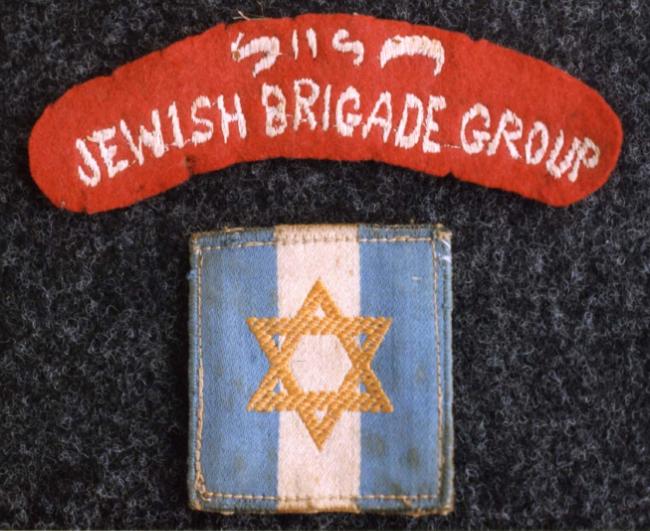 |
|
|
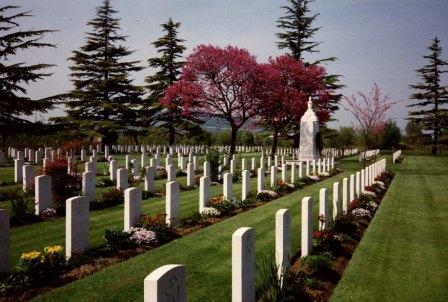
|
|
Da questo momento in poi, pur essendo la guerra mondiale in
pieno svolgimento, le navi di immigranti ebrei vengono respinte in Europa
dove gli occupanti troveranno sicura morte o coleranno a picco. Nello
stesso periodo Hitler, per minimizzare il progrom della "notte dei cristalli"
del novembre ’38, autorizza un certo numero di ebrei che ne fanno
richiesta a lasciare la Germania. Il 13 marzo 1939, ad Amburgo, la "Saint Louis", una nave battente bandiera nazista, molla le ancore. A bordo, 937
passeggeri, di cui 550 donne e bambini. Sono tutti ebrei tedeschi. Tutti
muniti di visto. Tutti con una destinazione: L'Avana, dove sperano di
soggiornare prima di ricevere il permesso d'entrata negli Stati Uniti. Il
23 maggio 1939, poco prima che la nave entri nelle acque territoriali
cubane, il governo la respinge: …NON REITERARE NÈ TENTARE DI AVVICINARSI
AL PORTO. Schroder, il comandante conosce il destino tragico che attende i
passeggeri al rientro in Germania. Decide perciò di rivolgersi ai paesi
del "mondo libero" e di chiedere accoglienza per i suoi passeggeri.
Roosevelt, il primo sollecitato, rifiuta. Il Canada rifiuta. Tutte le
nazioni dell'America latina rifiutano. A Berlino, Goebbels esulta:
"Nessuno li vuole!" Comincia così la terribile vicenda della "Saint Louis",
una nave lasciata alla deriva nell'Oceano. Verranno poi accolti in parte
in Inghilterra e in parte in paesi europei come la Francia, il Belgio, il
Lussemburgo invasi a loro volta un anno dopo dai Tedeschi, con una
prevedibile fine di quegli Ebrei.
http://www.storiamemoria.it/sites/default/files/e12_Conc.Reg_.Conselice.pdf
brigata ebraica |
| |
|
|
|

The cemetery is 3 km away from Rimini on the right side of the main road SS. 72 connecting Rimini to San Marino. It hosts 790 tombs of Indians and Nepalese. |
|
Il cimitero
GURKHA di RIMINI
(sopra a sx),
che comprende 790 tombe di indiani insieme a tombe di GURKHAS
nepalesi, si trova a 3 km a sud di Rimini sul lato destro della SS. 72 che conduce da Rimini a San Marino
. I Gurkhas prendono il nome da una località del Nepal dove 1200 anni fa si erano rifugiati nobili indiani in fuga dall’invasione islamica del loro paese. Addestrati all’uso delle armi, divennero soldati di mestiere. Nel 1700 si salvarono a stento, con l’aiuto degli Inglesi, da un tentativo di invasione cinese e da allora furono
(soldati mercenari) sempre fedelissimi al governo di S. M. britannica. Sono specializzati negli assalti all’arma bianca con i loro “khukuri”, una corta scimitarra arcuata con cui tagliano il collo ai nemici.
Nell’autunno 1944 ci furono aspri combattimenti nel corso dei quali
due divisioni Indiane la 4a e la 10a ebbero un ruolo determinante. Il
luogo fu scelto nell’ottobre 1945. All’interno di questo Cimitero di
Guerra si trova il Monumento Commemorativo delle Cremazioni (172 Caduti i
resti sono sepolti), uno dei tre esistenti in Italia, dedicato agli
Ufficiali e soldati Hindu e Sikh Caduti in questa area.
http://www.nepalesekhukuri.com/gurkhas.html
storia dei Gurkhas |
| |
|
|
|

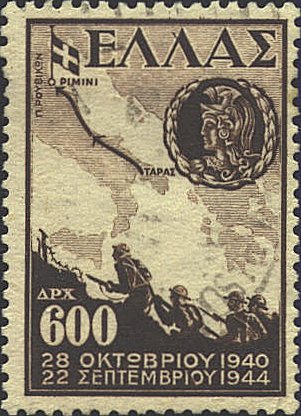 |
|
RICCIONE CIMITERO MILITARE GRECO
Il cimitero si trova su una collina sulla SS. 16 tra Riccione e Misano Adriatico sul lato destro della strada (n. 114 tombe di
greci)
Nel Sabato delle Anime prima della Domenica della Pentecoste e nell’ultima domenica di settembre si celebra una funzione commemorativa
(Rev.mo Archimandrita Dionysios Papavassiliou) in onore dei caduti per la liberazione della città di Rimini |
| |
|
|
|
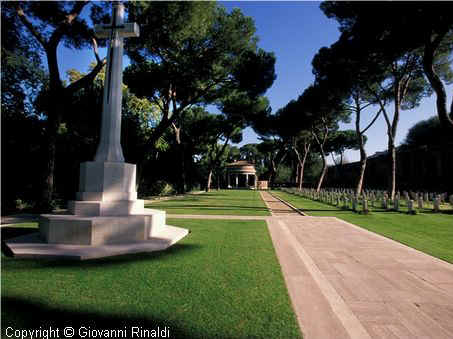
|
|
Rome British War Cemetery It is a small garden not so far from Monte Testaccio, close to the ancient Roman walls. Leaving the noisy road, across a gate, one enters a little round hall. All over, on the top of the wall there are two dates and two inscriptions in Latin
(a fianco) and in English: 1939 - 1945
These soldiers of the British Commonwealth gave their lives to preserve liberty and by their sacrifice restored the freedom of Italy and the ancient friendship of the Italian and British peoples.
Le Armate anglo-americane hanno subito 42.000 caduti in varie parti d’Italia: il Cimitero del Testaccio, quasi contiguo al Cimitero acattolico civile degli Inglesi, raccoglie 426 caduti, così suddivisi: 355 della Gran Bretagna - 22 Canadesi - 4 Australiani - 2 Indiani - 10 Neozelandesi - 28 Sud Africani - 1 Mauritius - 2 Palestinesi - 1 Pioniere Africa del Sud - 1 Indie
Occidentali. La maggior parte dei Caduti sepolti in questo cimitero
facevano parte delle truppe di presidio di stanza a Roma. Il cimitero
venne costituito subito dopo l’occupazione della città da parte degli
Alleati nel gennaio 1944. Il cimitero si trova lungo ed entro le mura Aureliane nella città di Roma. |
|
copyright Giovanni Rinaldi |
|
Nos Britannico nomini adscripti communis salutis usque ad mortem vindices ut Italiae libertas et ambobus populis vetus amicitia redintegrata sit sepulti iacemus. |
| |
|
|
|
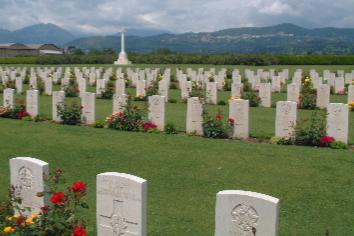 |
|
Salerno War Cemetery
Salerno is the chief town of its province and the war cemetery is nearly 10 miles to its south on the coast road. It was near Salerno that British and American forces landed on 8th and 9th September 1943, in an attempt to cut off German units. There was fierce fighting for days in the beachhead, and not until the 16th did the Germans begin to withdraw and the Allied hold become secure. The site of the cemetery was chosen in November 1943 and contains those who died in the battles in and following the landings, some from the General Hospital near Salerno and others who were brought in from south-western Italy. The cemetery contains 1, 750 British burials, 30 Canadian, 10 Australian, and 35 Indian, with small numbers of New Zealanders and South Africans
Cimitero di Guerra Britannico di Salerno.
Accoglie 1.849 Caduti. Situato a circa 16 chilometri a sud-est di Salerno,
lungo la rotabile per Battipaglia. I Caduti sono così distinti: 1.650 del
Regno Unito, 30 del Canada, 10 Australiani, 3 della Nuova Zelanda, 9 del
Sud Africa, 53 dell’India e del Pakistan, 111 Ignoti. Il Cimitero accoglie
i Caduti dei combattimenti a seguito dello sbarco a Salerno l’8 settembre
1943. Lo spiazzo prativo, che caratterizza i Cimiteri militari inglesi qui
è incorniciato da quattro edicole delimitate da 12 colonne di marmo |
| |
|
|
|
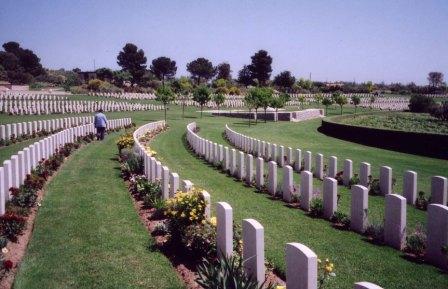 |
|
Sangro River War Cemetery One of the most difficult operations in the advance up the Adriatic coast in November and December 1943 was the crossing of the River Sangro. This, like the Moro and so many other rivers in Italy, runs off the central mountains to the sea, forming a formidable natural barrier to advances to the north or the south. The site of the cemetery lies two miles inland from the mouth of the River Sangro in the Province of Chieti. It was chosen by the British V Corps and into it were concentrated the bodies of men who had died in this sector during the fierce fighting and the subsequent static period. The 8th Indian Division was here during those months, 4th Indian arrived in January 1944, and 10th Indian in April; their participation is reflected in the number of their graves. The New Zealanders, too, were engaged in this area against stiff German opposition and later beyond the Sangro. The Canadians, who have two graves in this cemetery, buried most of those who died near here in Moro River Canadian War Cemetery, about eight miles to the north-west. Sangro River Cemetery contains 1, 800
(1768) British burials, 355 New Zealand, 75 South African and nearly
(circa) 400 Indian; there are also small numbers of Australian and former High Commission Territories' burials. The Cremation Memorial in the cemetery commemorates by name a further 520 Indians who were cremated in accordance with their faith. With a total of well over 3,100 burials and cremations this war cemetery ranks second in size (after Cassino War Cemetery) in Italy |
| |
|
Innâ li-'llâh wa ilai-hi râji'ûna Traduzione
a Dio apparteniamo e a lui ritorniamo |
|
Il Cimitero di Guerra del Fiume Sangro si trova su un ampio declivio collinoso a
nord di Torino di Sangro, a poco più di un chilometro dalla foce del
Sangro
(e Monumento Commemorativo delle Cremazioni. Indiano). Nel cimitero di
guerra sono accolti 2.617 Caduti. Raccoglie le spoglie di coloro che
caddero da novembre a dicembre 1943 nel settore adriatico. L’8a
Divisione Indiana occupò questo settore nei mesi citati, la 4a Divisione
Indiana arrivò nel gennaio 1944, mentre la 10a arrivò nell’aprile del
1944. Molti Caduti qui sepolti sono di religione musulmana. Anche la
Divisione Neozelandese ha qui seppelliti i suoi Caduti. All’interno di
questo Cimitero di Guerra si trova il Monumento Commemorativo delle
Cremazioni (517 Caduti), uno dei tre esistenti in Italia, dedicato agli
Ufficiali e soldati Hindu e Sikh Caduti in questa area e qui cremati |
|
Fiume Sangro novembre 1943. Tra le fila inglesi combattevano contingenti indiani d varia religione. Ne è testimonianza il cimitero inglese che si trova lungo la SS 16 Adriatica, nei pressi di Torino di Sangro (CH). Il cimitero include, secondo i registri ufficiali, 2344 tombe, di cui 355 di indiani delle Indian forces e del Royal Indian Army Service Corps. Delle 355 salme di soldati indiani 50 sono non identificate, 5 sono di indù, il resto sono musulmani, provenienti in prevalenza dal Pakistan, del 8°, 15° e 16° Punjab Regiment. La loro disposizione all'interno del cimitero, che si stende su un declivio ad anfiteatro rivolto a Sud, è distribuita sulle estremità. All'estremità Ovest vi è un altare che ricorda i corpi e i nomi dei caduti delle Indian Forces, con due iscrizioni in Hindi. A monte di tale monumento vi sono cinque file di 18, 18, 17, 18 e 16 tombe, in prevalenza musulmani (4 indù e 27 ignoti), e a valle ci sono due file di 8 e 17 tombe di militi non combattenti, tra i quali un solo musulmano. All'estremità Est vi sono tre gruppi di 5 file di 18 tombe ciascuna (eccetto l'ultima di 16 tombe) in prevalenza musulmane (1 indù e 19 ignote). In totale: 304 musulmani 5 indù 46 ignoti.Le lapidi dei soldati musulmani recano l'iscrizione in lingua araba
Huwa al-Ghafûr (Egli è il
Perdonatore) e, in basso, il versetto Coranico
|
| |
|
|
|
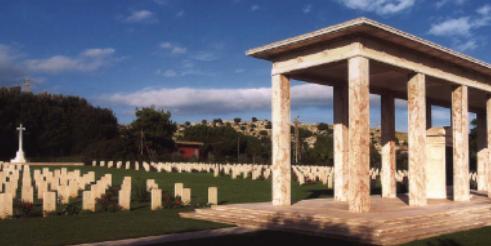 |
|
Syracuse War Cemetery is located in the Contrada of Canalicchio in the Comune and Province of Syracuse. It lies 3 kilometres west of Syracuse. The site of the cemetery was selected in 1943 at an early stage in the operations for the capture of Sicily. In this cemetery most of the graves are those of men who lost their lives in the landings in Sicily on 10th July, 1943, and in the early stages of the campaign on the island. They include those of a considerable number who belonged to the airborne force that was landed immediately west of the town during the night 9th-10th July. Graves were brought into Syracuse War Cemetery from as far north as Lentini. There are over 1,000, 1939-45 war casaulties commemorated in this site. Of these, over 100 from the 1939-45 War are unidentified and a special memorial has been erected to one British soldier known to have been buried among them. In addition, three special memorials commemorate men known to have been originally buried in other cemeteries in the region, but whose graves could not be found on concentration. The few grave from the 1914-18 War, was transferred here from Marsala British Cemetery. |
| |
|
|
|
Il Cimitero di Guerra di Siracusa accoglie 1.060
Caduti. Il luogo in cui si trova fu scelto nel 1943 durante le fasi della
conquista dell’Isola. La maggior parte di coloro che sono qui sepolti
persero la vita negli sbarchi in Sicilia dal 10 luglio 1943 e nelle fasi
della campagna della Sicilia. Un gran numero di tombe appartiene al
personale aviotrasportato inglese che atterrò nei dintorni della città
nella notte tra il 9 e il 10 luglio 1943. |
|
http://rapidttp.com/milhist/vol043wg.html
All’inizio d'aprile del 1945, gli Alleati lanciarono la loro offensiva finale contro le posizioni tedesche distribuite lungo una linea che attraversava l’Italia a sud di Bologna. La resistenza tedesca cominciava a sgretolarsi e gli Alleati riuscirono a disporsi a ventaglio attraverso la valle del Po. Le truppe della
6a Divisione Corazzata entrarono a Udine l'1 Maggio 1945, il giorno precedente la resa tedesca in Italia
(la guerra non è finita il 25 aprile). Le sepolture nel Cimitero di Guerra di Udine comprendono caduti degli ultimi giorni di guerra, alcuni prigionieri delle prime fasi della guerra, caduti dell’aviazione, sepolture successive provenienti dai presidi, ed alcuni deceduti provenienti dall’Ospedale Britannico installato a Udine per diversi mesi dopo il maggio 1945. Attualmente, il cimitero contiene 414 sepolture della
2a Guerra Mondiale, di cui 14 non identificate. Nel cimitero esiste anche uno speciale monumento che commemora un soldato della prima Guerra mondiale, all’epoca sepolto nel cimitero comunale di Versa, la cui tomba è andata perduta.
|
| |
|
|
|

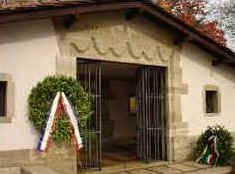 |
|
Udine War Cemetery
Udine was entered by troops on 1 May 1945 and burials in the cemetery include casualties from the last few days of fighting in Italy, some earlier prisoner of war and air force casualties, and, later, garrison burials and burials from 70 British General Hospital which was at Udine for several months from May 1945. Of the 414 burials in the cemetery, 40 are South African of which 32 were members of the South African Air Force. The War Cemetery is in Adegliacco (Tavagnacco Ud).
Cimitero di Guerra Britannico di Udine. Accoglie
415 Caduti. Di questi, 314 sono del Regno Unito, 11 Australiani, 45 del
Sud Africa ed 1 Ignoto. Le sepolture qui presenti includono i Caduti degli
ultimi giorni di guerra in Italia, alcuni prigionieri di guerra aviatori e
soldati dei presidi e pazienti dell’Ospedale Militare britannico di Udine.
All’interno del Cimitero vi è un monumento che commemora un soldato della
I Guerra Mondiale originariamente sepolto al cimitero di Varsa. Il
cimitero si trova nella località di Adegliacco, Comune di Tavagnacco, in
provincia di Udine. |
| |
|
|
|
Il Cimitero di Guerra di
Villanova accoglie 212 Caduti. Questo Cimitero fu allestito dalla 5a
Divisione Corazzata Canadese che riuscì a creare una testa di ponte sul
fiume Lamone. Molti dei Caduti durante questi combattimenti furono qui
sepolti, mentre altri perirono nel corso dell’avanzata verso la linea
finale raggiunta dai canadesi sul fiume Senio prima che lasciassero
l’Italia nel febbraio 1945
 |
|
Villanova
(Ra) War Cemetery Canada
Originally begun as a
battlefield cemetery, this permanent war graves site is located along
the Lamone River just outside the village of Villanova, in the comune
of Bagnacavallo. It was selected as a
cemetery by the 5th Canadian Armoured Division, which is heavily
represented here. There are 206 Canadian graves, including one unknown
soldier. There are also six soldiers from the UK. Most of the Canadian
war dead belonged to one of four regiments - the Lanark and Renfrew
Scottish Regiment (52), the 4th Princess Louise Dragoon Guards (34), the
Perth Regiment (34) and the Irish Regiment of Canada (25). For the most
part, they were killed following the Lamone River crossing in December
1944. A number also died in the advance to the Senio River and up to the
final days of the Italian campaign - in February 1945 for the majority
of Canadians.
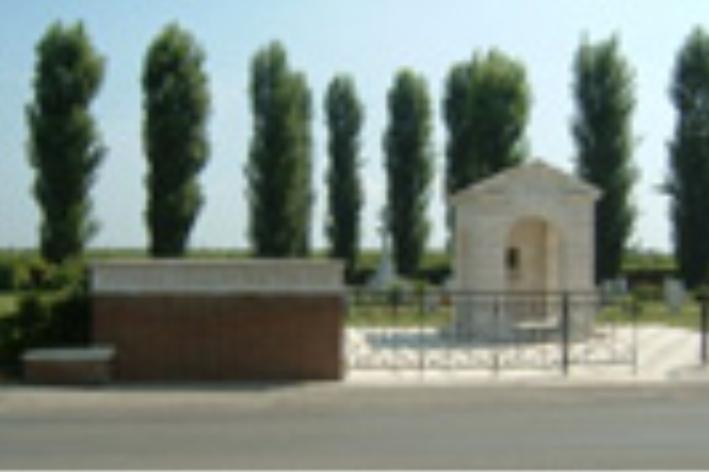 The site of the cemetery was chosen by the 5th Canadian
Armoured Division for battlefield burials. It was in the vicinity of
Villanova that troops of this Division succeeded in establishing a
bridgehead over the River Lamone in the night 10/11th December 1944.
West of this bridgehead there was heavy fighting in the following days,
when attempts were made to cross the three canals that run from Faenza
to the sea; from 12th to 15th December the Lanark and Renfrew Scottish
Regiment and the 4th Princess Louise Dragoon Guards suffered heavily in
these attempts, and 85 of the burials in the cemetery come from these
two regiments. Among the others are those of casualties incurred in the
advance to the final line held by the Canadians on the River Senio
before they left Italy in February 1945. There are now over 200, 1939-45
war casualties commemorated in this site. The site of the cemetery was chosen by the 5th Canadian
Armoured Division for battlefield burials. It was in the vicinity of
Villanova that troops of this Division succeeded in establishing a
bridgehead over the River Lamone in the night 10/11th December 1944.
West of this bridgehead there was heavy fighting in the following days,
when attempts were made to cross the three canals that run from Faenza
to the sea; from 12th to 15th December the Lanark and Renfrew Scottish
Regiment and the 4th Princess Louise Dragoon Guards suffered heavily in
these attempts, and 85 of the burials in the cemetery come from these
two regiments. Among the others are those of casualties incurred in the
advance to the final line held by the Canadians on the River Senio
before they left Italy in February 1945. There are now over 200, 1939-45
war casualties commemorated in this site. |
| |
|
|
|
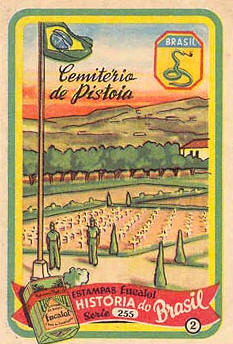 |
|
IL SACRARIO BRASILIANO
DI PISTOIA
Pochi lo sanno ma a Pistoia, alla deviazione della strada montalese
presso il tabernacolo di Seiarcole, esiste un Sacrario Brasiliano,
l’unico in Italia. Lo spazio, disegnato da Redig de Campos fra i filari
di viti della campagna di San Rocco che a stento resiste all'avanzare
delle costruzioni, ha oggi ben poco del Cimitero Militare come in
effetti lo è stato fino al 1960 quando le spoglie dei caduti vennero -
salvo una - (ri)portate in patria. Nessun cancello impedisce l’ingresso
all’area ben curata in cui si alternano prati, giardini alberi di vario
tipo, interrotti da un ampio viale che conduce ad un altare poggiante su
un basamento cruciforme bianco, sovrastato da un alto padiglione che
allude al calice liturgico, un altro padiglione sul lato destro ricorda
una tenda militare, le sagome si stagliano di fronte ad una grande
parete di pietra dove sono incisi i nomi dei caduti - alcuni di evidenti
origini italiane - che si riflettono sull’acqua della lunga ed ampia
vasca antistante. Il fuoco di un braciere che arde perennemente sullo
sfondo suggestivo delle colline sembra ricordare i luoghi dove
combatterono i soldati brasiliani. Quattro date preludono
all’intervento brasiliano: il vertice interamericano del luglio 1940
all’Avana, che aveva sancito l'obbligo per i paesi aderenti ad
affiancare chi fosse stato aggredito da potenze straniere, la rottura
delle relazioni diplomatiche con Italia, Germania e Giappone nel gennaio
1942, la dichiarazione di guerra dell’agosto 1942 seguita
all'affondamento di navi brasiliane da parte dei tedeschi e l’incontro
di Natal del gennaio 1943 fra Roosevelt e Vargas che decise l’effettivo
intervento brasiliano.
La Feb schierata il 15 settembre 1944 sul Litorale Tirrenico la FEB
iniziò subito le operazioni che da Massarosa a Camaiore e poi per la
Valle del Serchio la portarono a liberare numerose località della
Garfagnana fino a Barga. Da segnalare già in questi frangenti gli
scontri anche con reparti italiani delle quattro divisioni dell'esercito
di Salò appena rientrate dall’ addestramento in Germania: tedeschi e
americani avevano voluto provare le proprie "riserve", sul cui valore
combattivo nutrivano non pochi dubbi. Stabilito il quartier generale
Pistoia, la FEB venne, alla fine di ottobre, trasferita nella Valle del
Reno. Con l’avanzare del fronte appenninico nell’ inverno 1944/45 la FEB
colse importanti vittorie, in particolare vengono ricordate quelle di
Monte Castello - posizione tenuta dai tedeschi che aveva fama di essere
imprendibile - Castelnuovo, Montese, Zocca e, dopo lo sfondamento la
Pianura Padana.
Nella città toscana fino al rimpatrio funzionò il Quartier Generale di
Retrovia dove erano concentrati i più importanti servizi della FEB: l’
Ospedale da Campo, l’Intendenza di Finanza in Piazza S. Lorenzo, il
Magazzino in via dei Baroni, il Parco Auto, il Servizio Postale ed, in
via Monte Sabotino. riassunto e ridotto da un articolo di Carlo Onofrio
Gori |






































 CIMITERO MILITARE EBRAICO PIANGIPANE
CIMITERO MILITARE EBRAICO PIANGIPANE













 The site of the cemetery was chosen by the 5th Canadian
Armoured Division for battlefield burials. It was in the vicinity of
Villanova that troops of this Division succeeded in establishing a
bridgehead over the River Lamone in the night 10/11th December 1944.
West of this bridgehead there was heavy fighting in the following days,
when attempts were made to cross the three canals that run from Faenza
to the sea; from 12th to 15th December the Lanark and Renfrew Scottish
Regiment and the 4th Princess Louise Dragoon Guards suffered heavily in
these attempts, and 85 of the burials in the cemetery come from these
two regiments. Among the others are those of casualties incurred in the
advance to the final line held by the Canadians on the River Senio
before they left Italy in February 1945. There are now over 200, 1939-45
war casualties commemorated in this site.
The site of the cemetery was chosen by the 5th Canadian
Armoured Division for battlefield burials. It was in the vicinity of
Villanova that troops of this Division succeeded in establishing a
bridgehead over the River Lamone in the night 10/11th December 1944.
West of this bridgehead there was heavy fighting in the following days,
when attempts were made to cross the three canals that run from Faenza
to the sea; from 12th to 15th December the Lanark and Renfrew Scottish
Regiment and the 4th Princess Louise Dragoon Guards suffered heavily in
these attempts, and 85 of the burials in the cemetery come from these
two regiments. Among the others are those of casualties incurred in the
advance to the final line held by the Canadians on the River Senio
before they left Italy in February 1945. There are now over 200, 1939-45
war casualties commemorated in this site.